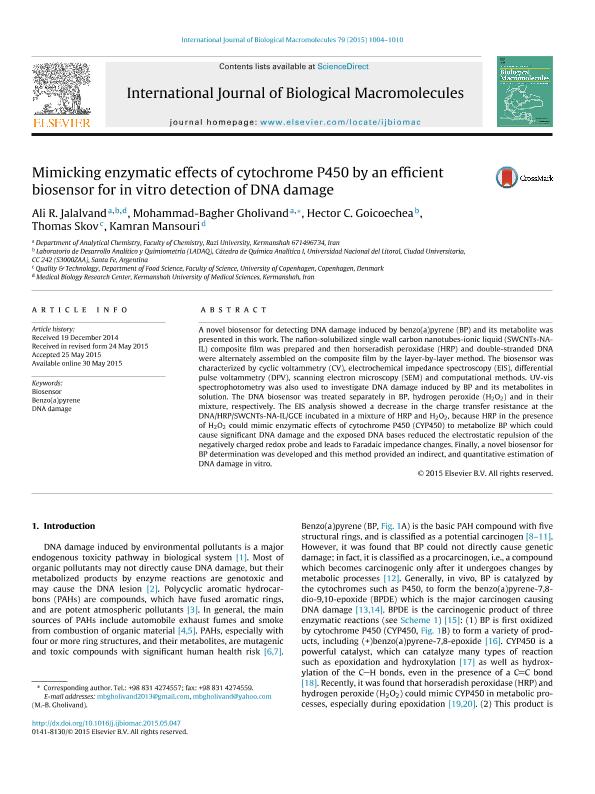Mostrar el registro sencillo del ítem
dc.contributor.author
Jalalvand, Ali R.

dc.contributor.author
Gholivand, Mohammad Bagher

dc.contributor.author
Goicoechea, Hector Casimiro

dc.contributor.author
Skov, Thomas

dc.contributor.author
Mansouri, Kamran

dc.date.available
2017-06-02T15:57:18Z
dc.date.issued
2015-05
dc.identifier.citation
Jalalvand, Ali R.; Gholivand, Mohammad Bagher; Goicoechea, Hector Casimiro; Skov, Thomas; Mansouri, Kamran; Mimicking enzymatic effects of cytochrome P450 by an efficient biosensor for in vitro detection of DNA damage; Elsevier; International Journal of Biological Macromolecules; 79; 5-2015; 1004-1010
dc.identifier.issn
0141-8130
dc.identifier.uri
http://hdl.handle.net/11336/17364
dc.description.abstract
A novel biosensor for detecting DNA damage induced by benzo(a)pyrene (BP) and its metabolite was presented 18 in this work. The nafion-solubilized single wall carbon nanotubes-ionic liquid (SWCNTs-NA-IL) composite film 19 was prepared and then horseradish peroxidase (HRP) and double-stranded DNA were alternately assembled on 20 the composite film by the layer-by-layer method. The biosensor was characterized by cyclic voltammetry (CV), 21 electrochemical impedance spectroscopy (EIS), differential pulse voltammetry (DPV), scanning electron 22 microscopy (SEM) and computational methods. UVvis spectrophotometry was also used to investigate DNA 23 damage induced by BP and its metabolites in solution. The DNA biosensor was treated separately in BP, 24 hydrogen peroxide (H2O2) and in their mixture, respectively. The EIS analysis showed a decrease in the charge 25 transfer resistance at the DNA/HRP/SWCNTs-NA-IL/GCE incubated in a mixture of HRP and H2O2, because 26 HRP in the presence of H2O2 could mimic enzymatic effects of cytochrome P450 (CYP450) to metabolize BP 27 which could cause significant DNA damage and the exposed DNA bases reduced the electrostatic repulsion of the 28 negatively charged redox probe and leads to Faradaic impedance changes. Finally, a novel biosensor for BP 29 determination was developed and this method provided an indirect, and quantitative estimate of DNA damage in 30 vitro.
dc.format
application/pdf
dc.language.iso
eng
dc.publisher
Elsevier

dc.rights
info:eu-repo/semantics/openAccess
dc.rights.uri
https://creativecommons.org/licenses/by-nc-nd/2.5/ar/
dc.subject
Biosensor
dc.subject
Dna Damage
dc.subject
Benzo(A)Pyrene
dc.subject.classification
Química Analítica

dc.subject.classification
Ciencias Químicas

dc.subject.classification
CIENCIAS NATURALES Y EXACTAS

dc.title
Mimicking enzymatic effects of cytochrome P450 by an efficient biosensor for in vitro detection of DNA damage
dc.type
info:eu-repo/semantics/article
dc.type
info:ar-repo/semantics/artículo
dc.type
info:eu-repo/semantics/publishedVersion
dc.date.updated
2017-05-04T18:43:52Z
dc.journal.volume
79
dc.journal.pagination
1004-1010
dc.journal.pais
Países Bajos

dc.journal.ciudad
Amsterdam
dc.description.fil
Fil: Jalalvand, Ali R.. Razi University. Department of Analytical Chemistry; Irán. Kermanshah University of Medical Sciences; Irán. Universidad Nacional del Litoral. Facultad de Ingeniería Química. Laboratorio de Química Analitica; Argentina
dc.description.fil
Fil: Gholivand, Mohammad Bagher. Razi University. Department of Analytical Chemistry; Irán
dc.description.fil
Fil: Goicoechea, Hector Casimiro. Consejo Nacional de Investigaciones Científicas y Técnicas. Centro Científico Tecnológico Conicet - Santa Fe; Argentina. Universidad Nacional del Litoral. Facultad de Ingeniería Química. Laboratorio de Química Analitica; Argentina
dc.description.fil
Fil: Skov, Thomas. Universidad de Copenhagen; Dinamarca
dc.description.fil
Fil: Mansouri, Kamran. Kermanshah University of Medical Sciences; Irán
dc.journal.title
International Journal of Biological Macromolecules

dc.relation.alternativeid
info:eu-repo/semantics/altIdentifier/doi/http://dx.doi.org/10.1016/j.ijbiomac.2015.05.047
dc.relation.alternativeid
info:eu-repo/semantics/altIdentifier/url/http://www.sciencedirect.com/science/article/pii/S0141813015003888
Archivos asociados
